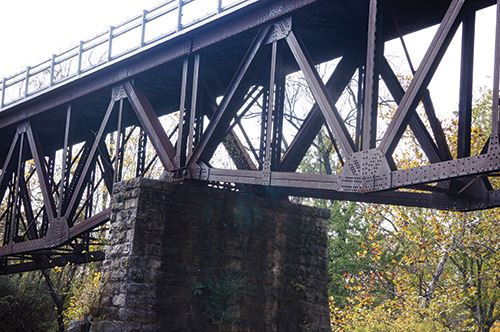Rails to trails
Composite deck converts old railroad span to pedestrian trail crossing.
Share
Read Next
The Rails-To-Trails Conservancy (Washington, DC, US) was formed in 1983 to re-purpose unused rail corridors nationwide in support of a growing network of recreational walking and biking trails. Broad Top Township in Bedford County, located between Pittsburgh and Harrisburg in southern Pennsylvania, participates in Rails-To-Trails through a local nonprofit organization. That group wanted to convert an abandoned HB&T railroad grade to a pedestrian- and bicycle-friendly trail that would connect two existing public parks, but was faced with having to do the same to an existing 108m railroad trestle bridge spanning a river that separated the parks.
The nonprofit chose to work with Composite Advantage (CA, Dayton, OH, US), for a new, FiberSPAN fiber-reinforced polymer (FRP) composite bridge deck. The deck needed to fit atop the old iron truss support structure. Although the latter was still structurally adequate, its two upper girders, on which the deck would sit, were spaced 3m on center, a wide spacing for a pedestrian bridge, says CA president Scott Reeve: “The wider the support spacing, the greater the deck depth had to be to meet deflection criteria under load of L/500.” (Maximum deflection equals spacing length divided by 500.) Further, says Reeve, “Unlike conventional bridge decks, old structures like the HB&T trestle bridge used girder flanges with rivet heads on top” (see second photo, at left). That prevented the use of a simple flat panel.
Given the distance between the girders and the exposed rivet heads, CA molded 15 4m-wide by 125-mm-deep sandwich-design deck panels, with upper and lower skins of fiberglass. To ensure they would seat properly on the girders, says Reeve, “the FRP deck panels were molded with integral spacers or steps on the underside to ensure the deck would clear the rivet heads.” (Steps shown in third photo at left were made to seat on the flat area between the rows of rivets on each large girder in the second photo.) Lastly, molded-in steel box tubing on the outer edges provided a high-strength load path for support when railing posts were attached.
A Broad Top Township crew bolted down the FRP deck panels to threaded shear studs welded to the tops of the girders. The FRP deck panels took just three days to install and the HB&T bridge and trail opened to the public in November 2014.
Related Content
-
TU Munich develops cuboidal conformable tanks using carbon fiber composites for increased hydrogen storage
Flat tank enabling standard platform for BEV and FCEV uses thermoplastic and thermoset composites, overwrapped skeleton design in pursuit of 25% more H2 storage.
-
3D-printed CFRP tools for serial production of composite landing flaps
GKN Aerospace Munich and CEAD develop printed tooling with short and continuous fiber that reduces cost and increases sustainability for composites production.
-
The potential for thermoplastic composite nacelles
Collins Aerospace draws on global team, decades of experience to demonstrate large, curved AFP and welded structures for the next generation of aircraft.












.jpg;maxWidth=300;quality=90)



